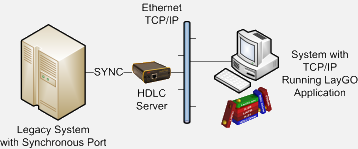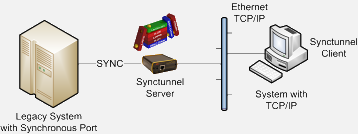The framing part of the HDLC standard specifies how transmission frames are delimited, how data are transmitted transparently and how error detection is performed. Traditionally a communication chip handles these features while higher layer protocols, specifically link procedures (e.g. LAPB) have been handled by software. The HDLC framing is used by many devices and is what we call Raw Mode HDLC.
There are two options for accessing HDLC (or HDLC/LAPB) devices over TCP/IP using Advanced Relay's products, with the LayGO™ Multiprotocol Toolkit or using the LayGO™ PXSe as an HDLC gateway.
LayGO™ Multiprotocol Toolkit
Using the LayGO™ Multiprotocol Toolkit (which includes synchronous hardware), the user can easily read and write data to a synchronous device that uses raw mode HDLC, or even more complex protocol stacks, for instance HDLC/LABP or X.25/LAPB.
It is important to note that if the user does not need or does not want to use TCP/IP, a device like the LayGO™ PXSu can be used to connect a PC directly to an HDLC device.

LayGO™ PXSe with HDLC Gateway
Using the LayGO™ PXSe as an HDLC gateway, the user can access a synchronous device as a TCP/IP capable device. The LayGO™ PXSe acts as a synchronous to TCP/IP gateway, taking care of all the necessary conversions. The user just reads or writes to a TCP/IP port.
Note that in this case the LayGO™ Protocol Stack is still used internally in the PXSe, but the user need not to be aware of this fact. All details of the synchronous protocol are handled internally by the gateway application.
